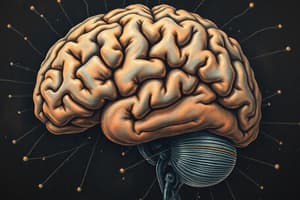Podcast
Questions and Answers
Match the following terms with their definitions related to neuroplasticity:
Match the following terms with their definitions related to neuroplasticity:
Neuroplasticity = Changes in the strength and connectivity of neural connections. Functional Neuroplasticity = The brain's ability to change and adapt throughout life. Structural Neuroplasticity = Changes in the physical structure of neurons and their connections. Synaptogenesis = Formation of new neural connections.
Match the following mechanisms with their descriptions related to neuroplasticity:
Match the following mechanisms with their descriptions related to neuroplasticity:
Synaptic Pruning = Formation of new neural connections. Synaptogenesis = Elimination of inactive or redundant neural connections. Dendritic Remodeling = Changes in the shape and structure of dendrites. Neurogenesis = Growth of new neurons in certain parts of the brain.
Match the following factors with their influences on neuroplasticity:
Match the following factors with their influences on neuroplasticity:
Experience and Learning = Promotes neuroplasticity through novel experiences. Exercise and Physical Activity = Decreases neuroplasticity with age. Sleep and Relaxation = Essential for neuroplasticity and cognitive function. Aging = Neuroplasticity decreases, but can be maintained through active lifestyle.
Match the following concepts with their relationships to neuroplasticity:
Match the following concepts with their relationships to neuroplasticity:
Match the following terms with their descriptions related to neuroplasticity:
Match the following terms with their descriptions related to neuroplasticity:
Match the following mechanisms with their effects on neuroplasticity:
Match the following mechanisms with their effects on neuroplasticity:
Match the following factors with their influences on neuroplasticity:
Match the following factors with their influences on neuroplasticity:
Match the following concepts with their relationships to neuroplasticity:
Match the following concepts with their relationships to neuroplasticity:
Match the following terms with their descriptions related to neuroplasticity:
Match the following terms with their descriptions related to neuroplasticity:
Match the following mechanisms with their effects on neuroplasticity:
Match the following mechanisms with their effects on neuroplasticity:
Match the following factors with their influences on neuroplasticity:
Match the following factors with their influences on neuroplasticity:
Flashcards are hidden until you start studying
Study Notes
Neuroplasticity
Definition
- Neuroplasticity refers to the brain's ability to change and adapt throughout life in response to new experiences, environments, and learning.
Types of Neuroplasticity
- Functional Neuroplasticity: Changes in the strength and connectivity of neural connections.
- Structural Neuroplasticity: Changes in the physical structure of neurons and their connections.
Mechanisms of Neuroplasticity
- Synaptic Pruning: Elimination of inactive or redundant neural connections.
- Synaptogenesis: Formation of new neural connections.
- Neurogenesis: Growth of new neurons in certain parts of the brain.
- Dendritic Remodeling: Changes in the shape and structure of dendrites (branching extensions of neurons).
Factors Influencing Neuroplasticity
- Experience and Learning: Novel experiences and learning stimulate neuroplasticity.
- Exercise and Physical Activity: Regular exercise promotes neuroplasticity.
- Sleep and Relaxation: Adequate sleep and relaxation are essential for neuroplasticity.
- Aging: Neuroplasticity decreases with age, but can be maintained through active lifestyle and cognitive stimulation.
Clinical Relevance of Neuroplasticity
- Recovery from Brain Injury: Neuroplasticity enables the brain to compensate for damaged areas.
- Neurological Disorders: Neuroplasticity is involved in the development and progression of conditions such as Alzheimer's disease, Parkinson's disease, and depression.
- Neurotherapy and Rehabilitation: Neuroplasticity-based interventions aim to improve cognitive and motor function in individuals with brain disorders or injuries.
Studying That Suits You
Use AI to generate personalized quizzes and flashcards to suit your learning preferences.




